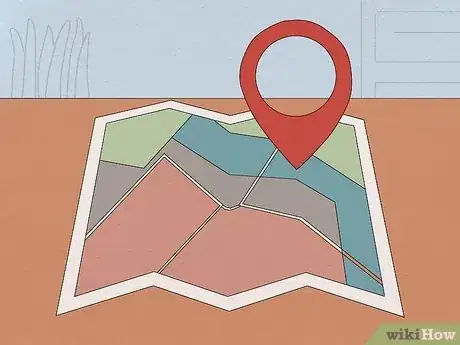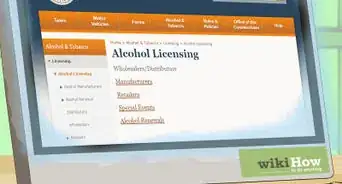This article was co-authored by Patricia Chukerman. Patricia Chukerman is an Image Consultant & Marketing Specialist and the Owner of Paperworks Image Consulting and Stoned on Rocks. With more than 36 years of experience, she specializes in helping companies decide how to market themselves. In addition to her work with businesses, she also has more than four years of acting experience and more than five years of crafting experience. Patricia earned her BA from The University of Illinois Chicago. Patricia is also the President of the Dania Beach Chamber of Commerce and the President of the Hollywood Florida Scholarship Foundation.
wikiHow marks an article as reader-approved once it receives enough positive feedback. This article has 20 testimonials from our readers, earning it our reader-approved status.
This article has been viewed 495,828 times.
If you've ever dreamed of opening a bakery, your chances of success may be high: baked goods and bakeries are among the fastest-growing industries for small businesses. In 2010, bakeries accounted for 2.1% of the US GDP.[1] . You'll need some planning and entrepreneurial savvy, but if you're willing to work hard, you can make a name for yourself – or at least for your cupcakes and baguettes.
Steps
Planning Your Bakery
-
1Decide what type of bakery you want to open.There are bakeries that only sell baked goods, those that sell sandwiches, and others that include coffee to go. Think about what kinds of goods you want to offer.
- Choose whether you want to sell conventional baked goods, or a more niche product like organic, gluten-free, or vegan (e.g., egg- and dairy-free) products.
-
2Decide on what kind of space you want. There are several options, and your choice may depend on the amount of capital you're able to raise. Keep in mind that storefronts have the attractive factor of foot-traffic and a recognizable place in the business community. Working from home is more affordable, but you may have less work space and will need to bring your kitchen up to health department standards.
- Online bakeries are a good way to start if you're low on capital. You can work from home and sell your goods through a website. You'll need to hire a web designer and figure out a system for ordering online.
- A counter-service bakery is a small commercial space where you sell baked goods to customers over a counter. You'll likely need at least one other employee.
- Sit-down bakeries have an area where customers order their baked goods, and tables and chairs where they can eat.[2]
Advertisement -
3Research the competition in the area to find out if there's a demand for the type of baked goods you want to sell. For example, if the local supermarket sells conventional, organic, and vegan baked goods at reasonable prices, you might not be able to compete. But, you could open up a new market if you open a bakery with a pleasant seating area and offer specialty baked goods and fresh sandwiches.
-
4Make a list of equipment you need to start your business. You'll need scales, bowls, pan racks, ovens, mixers, butcher-block tables, display cases (if working from a commercial space), and refrigerators.
- Check with the local consumer health department, which is responsible for setting regulations. Make sure you have included all necessary items in your list.
-
5Decide which baked goods to sell at your bakery and what ingredients you need. Some specialty ingredients can be quite costly, so you'll need this information prior to making your business plan.
-
6Draw up a business plan. Looking at your business from every angle is essential to ensuring a smooth start to your bakery.
- Define your business. Think about the products and services you provide, and your target customers (working professionals, busy mothers, catering businesses, etc.).
- Set goals about how much profit you'll make over the first few years, and any expansions you hope to make to your product line, services, or business space.
- Make a plan to generate revenue. You'll need to calculate the cost of producing your goods and how much you'll sell them for. For example, coffee can have a 500% markup, while specialty baked goods like vegan, gluten-free cupcakes might have a mere 50% markup.[3]
- Calculate startup costs. These are one-time expenses, but you'll need to figure out how you're going to survive financially before you start making a profit.[4]
- Calculate the costs of your location, supplies, staff, taxes, and marketing. Balance them against your projected income to determine how much you'll need to sell in order to make a profit.
-
7Review your business plan with an accountant. Be prepared for them to find additional expenses you've overlooked. An accountant can also advise you about how the costs of a startup can affect your tax returns.
-
8Raise the necessary capital for opening a bakery. Ask your bank for a business loan or talk to private investors to raise the money.
-
9Choose the location for your bakery. Make sure it's easily accessible, has plenty of foot traffic, and meets all safety requirements, which vary from state to state.
- Be very choosy as you look for locations. Look at several, compare prices, talk to local business owners, and research the area(s) to find the best fit for your bakery.[5]
-
10Register your business with your city and apply for a sales permit to sell baked goods. At the very least, you'll need a business license, tax identification number and liability insurance. Depending on your region, you may need a separate license for a wholesale or retail baking business. You'll also need to apply for a food-handling permit.
Opening Your Bakery
-
1Buy your equipment and have it professionally installed. Make sure everything is safe and up to code. This is also the time to buy your supplies:
- To-go items for counter-top bakeries, including boxes, coffee cups, and napkins.
- Tables and chairs for sit-down bakeries. (You'll also need plates, cups, and utensils.)
- Business items like a telephone, fax machine, and cash register.
- If you plan to make deliveries, you may need a delivery truck, and portable refrigeration and/or warming units.
-
2Interview potential employees. Make sure they are friendly, efficient and trustworthy. You may want to establish a probation period before officially hiring anyone. If they are going to help with the baking, set the standard high and make sure they're capable of maintaining it. If they'll be working at the counter only, they must be reliable.[6]
-
3Call your local consumer health agency and have your bakery inspected for health safety. Before you do so, verify that everything is in place and ready to run.
-
4Set business hours according to your customer base. When are your target customers out and about? If they'll want to stop on the way to work for coffee and a pastry, you'll need to open early. Should you stay open later to attract a young cafe crowd in the evening?
- Remember to factor in baking hours, which extend your work day.
-
5Start baking! Buy all necessary ingredients and prepare your first batch of baked goods. Make a lasting first impression with attractive pastries that are as delicious as they look.
-
6Market your business. Advertise your bakery in the local newspaper, on flyers and online. You'll need to do some work to promote your bakery as the original wonder it is.
- Keep a blog: writing about baking topics or sharing recipes can generate interest in your customer base.
- Use social media. Announce your bakery's opening on social networking sites, and create a page for your bakery. This makes it easy for customers to get information about what you offer, where you're located, and when you're open. You can also offer discounts for visitors to your page.
- Establish relationships with other local businesses. You may be able to put up fliers in their lobbies, for example, or offer them free samples to get the word out.[7]
-
7Focus on customer service. Happy customers are returning customers. Make sure their experience in your bakery is a positive one. Counter service should be friendly and efficient, and the atmosphere (even if it's minimal) should be clean, positive, and inviting.[8]
Growing Your Bakery
-
1Expand your line of products and services. Once you're into the swing of things, consider adding new products. You can start off small, such as trying out seasonal specials. For a larger step, add sandwiches and soups to your menu, or speciality items.
- If you're ready to diversify your business, look into taking online orders, adding a food truck, or working with catering companies.[9]
-
2Find new ways to advertise. Don't sit on your laurels even if business is going well. You'll need to continuously expand your marketing strategies. Keep up your social media profile, participate in charity events, and add your presence to local fairs and markets. Don't forget to distribute business cards at every opportunity.[10]
-
3Plan ahead for retirement. Remember that, in the long run, you'll need finances for retirement. Talk to a financial advisor and work out a savings plan.[11]
Community Q&A
-
QuestionHow can I find financing for my business?
 Community AnswerFind sponsors and donors. There are many people willing to sponsor and donate to smaller and local businesses. You may take out a loan, if you must. But be warned that a loan may be difficult to pay off, and you can lose money over time. I recommend starting saving early. Throw a fundraising event, sell merchandise! Be creative!
Community AnswerFind sponsors and donors. There are many people willing to sponsor and donate to smaller and local businesses. You may take out a loan, if you must. But be warned that a loan may be difficult to pay off, and you can lose money over time. I recommend starting saving early. Throw a fundraising event, sell merchandise! Be creative! -
QuestionWhat are all the documents I need to apply for registration?
 Community AnswerOrganization license, health permit, food handlers permit, and assumed business name license.
Community AnswerOrganization license, health permit, food handlers permit, and assumed business name license. -
QuestionAm I allowed to tell the customer when I can't do something?
 Community AnswerYes. You should always be honest and straightforward with your clientele.
Community AnswerYes. You should always be honest and straightforward with your clientele.
Warnings
- Never open a bakery without all necessary permits.⧼thumbs_response⧽
References
- ↑ http://americanbakers.org/industry-data/
- ↑ http://articles.bplans.com/the-bakers-guide-to-opening-a-successful-bakery/
- ↑ http://nymag.com/guides/changeyourlife/16046/
- ↑ http://articles.bplans.com/the-bakers-guide-to-opening-a-successful-bakery/
- ↑ http://articles.bplans.com/the-bakers-guide-to-opening-a-successful-bakery/
- ↑ http://articles.bplans.com/the-bakers-guide-to-opening-a-successful-bakery/
- ↑ http://articles.bplans.com/the-bakers-guide-to-opening-a-successful-bakery/
- ↑ http://articles.bplans.com/the-bakers-guide-to-opening-a-successful-bakery/
- ↑ http://articles.bplans.com/the-bakers-guide-to-opening-a-successful-bakery/
About This Article
To open a bakery, start by drawing up a business plan that includes your vision of what your bakery will sell, start-up costs, and profit goals. Once you secure a location, buy your equipment, including refrigerators, display cases, fax machines, and cash registers. You’ll also need to call your local consumer health agency and have your bakery inspected for health safety. Then, it's time to hire employees and market your business on social media. To learn how to grow your business, keep reading!

















































































